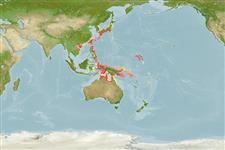>
Gobiesociformes (Clingfishes) >
Gobiesocidae (Clingfishes and singleslits) > Diademichthyinae
Etymology: Pherallodichthys: Greek, pher = monster + Greek, allo =other + Greek, ichthys = fish.
Environment: milieu / climate zone / depth range / distribution range
Ecología
marino demersal. Tropical
Distribución
Países | Áreas FAO | Ecosistemas | Ocurrencias, apariciones | Point map | Introducciones | Faunafri
Western Pacific: Japan. Recently reported from the Philippines (Ref. 5211).
Tamaño / Peso / Age
Maturity: Lm ? range ? - ? cm
Max length : 3.0 cm TL macho / no sexado; (Ref. 35774); common length : 1.9 cm SL macho / no sexado; (Ref. 559)
Often inhabit intertidal or subtidal reefs (Ref. 47249). Fish-egg eaters (Ref. 54616). Most species reported to feed on zooplankton or benthic animals (Ref. 28114). May change its feeding habits when growing to an obligate fish-egg eater targeting demersal egg spawners (Ref. 54616).
Life cycle and mating behavior
Madurez | Reproducción | Puesta | Huevos | Fecundidad | Larva
Masuda, H., K. Amaoka, C. Araga, T. Uyeno and T. Yoshino, 1984. The fishes of the Japanese Archipelago. Vol. 1. Tokai University Press, Tokyo, Japan. 437 p. (text). (Ref. 559)
IUCN Red List Status (Ref. 130435: Version 2024-2)
Threat to humans
Harmless
Human uses
Herramientas
Special reports
Download XML
Fuentes de Internet
Estimates based on models
Preferred temperature (Ref.
123201): 24.5 - 29.3, mean 28.7 °C (based on 696 cells).
Phylogenetic diversity index (Ref.
82804): PD
50 = 1.0000 [Uniqueness, from 0.5 = low to 2.0 = high].
Bayesian length-weight: a=0.00389 (0.00180 - 0.00842), b=3.12 (2.94 - 3.30), in cm total length, based on all LWR estimates for this body shape (Ref.
93245).
Nivel trófico (Ref.
69278): 3.5 ±0.48 se; based on food items.
Resiliencia (Ref.
120179): Alto, población duplicada en un tiempo mínimo inferior a 15 meses (Preliminary K or Fecundity.).
Fishing Vulnerability (Ref.
59153): Low vulnerability (10 of 100).
